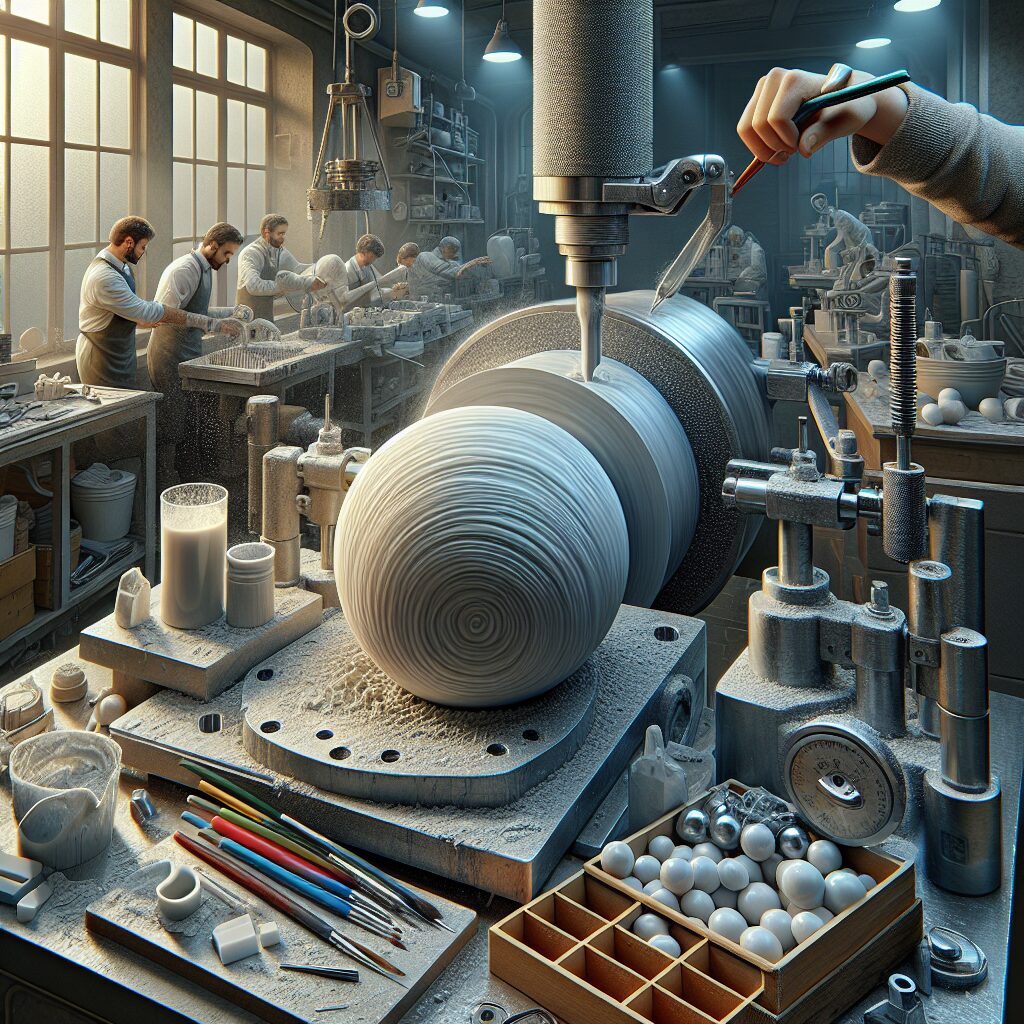Precision molding, also known as injection molding, is a manufacturing process that involves the creation of complex and detailed shapes using molten material. This technique is widely used in the production of various products, from automotive components to medical devices. One unique aspect of precision molding is its ability to fabricate perfectly spherical balls with high dimensional accuracy. This precision is achieved by injecting the molten material into a mold, which is then cooled and solidified to form the desired shape. The art of ball fabrication requires not only technical expertise but also meticulous attention to detail, making it an essential process in many industries.
The impacts of precision molding in different fields are substantial. For instance, in the automotive industry, precision-molded balls are used in ball joints, allowing for smooth motion and reducing friction between moving parts. In the medical field, precision-molded balls are utilized in medical devices such as check valves, where their precise dimensions ensure accurate and consistent performance. Moreover, precision molding offers the ability to produce balls with a wide range of materials, including metals, plastics, and ceramics, thereby expanding the possibilities for their applications.
Now, let’s delve into the key takeaways from this article. We will explore the various materials used in precision molding and their unique features, the importance of dimensional accuracy, and the advancements in technology that have improved the precision molding process. Furthermore, we will discuss the challenges faced by manufacturers in achieving high-quality ball fabrication and how they can overcome these obstacles. By understanding these key aspects, readers will gain a deeper insight into the art of precision molding and its significance in diverse industries.
Key Takeaways
1. Precision molding is a highly skilled art that involves fabricating small balls with high accuracy and consistency using specialized techniques and equipment.
2. The process of precision molding begins with the selection of materials, such as stainless steel, ceramics, or glass, which are then formed into precise ball shapes through a combination of molding and grinding.
3. The resulting precision balls have a wide range of applications in various industries, including aerospace, automotive, medical, and electronics, where they are used in critical components such as bearings, valves, and medical devices.
4. Precision molding requires rigorous quality control measures to ensure that the manufactured balls meet the required specifications, such as size, roundness, and surface finish, which are crucial for their functional performance.
5. Ongoing advancements in precision molding technology have enabled manufacturers to produce balls with even higher precision and efficiency, resulting in improved product quality and reduced costs.
Can Precision Molding Truly Be Considered an Art Form in the Fabrication of Ball?
The Intricate Process of Precision Molding
Precision molding, a complex technique performed in the realm of manufacturing, has proven its prowess in fabricating a wide range of products. Among these, the fabrication of balls stands out as a true testament to the artistry behind precision molding.
When it comes to ball fabrication, precision molding involves meticulous attention to detail and the use of advanced machinery. The process starts with the selection of suitable materials, such as plastics or metals, which are then melted and injected into molds. These molds, crafted with utmost accuracy, determine the final shape and dimensions of the ball.
The Role of Design and Engineering
Design and engineering play a pivotal role in the precision molding process of ball fabrication. The initial stages involve creating a comprehensive design, considering factors such as size, weight, and intended use. Engineers work closely with designers to ensure the structural integrity of the ball, taking into account the material properties and potential stresses it may face during use.
The design is then translated into a three-dimensional CAD model, which serves as the blueprint for the creation of molds, ensuring precision in the fabrication process. The utilization of cutting-edge software allows for virtual testing and analysis, further enhancing the quality and performance of the final product.
The Importance of Material Selection
Choosing the right materials for precision molding is vital in achieving the desired characteristics and performance of the fabricated ball. Factors such as durability, strength, and resistance to wear are taken into consideration. Depending on the application, different materials like steel, rubber, or specialized plastics may be utilized.
Material selection also extends to the mold itself. To ensure the precise replication of the ball’s dimensions, the mold material must exhibit high dimensional stability and resistance to wear and tear. Common materials for mold production include hardened tool steels or aluminum alloys.
The Influence of Precision on Ball Performance
When it comes to ball fabrication, precision is paramount. The accuracy and uniformity achieved through precision molding significantly impact the performance and quality of the final product. From the consistency of spherical shape to the weight distribution, precision molding ensures that each ball meets strict standards and performs predictably in various applications.
Applications and Industries Benefiting from Precision-Molded Balls
Precision-molded balls find application across various industries, showcasing their versatility and reliability. From bearing balls in automotive and aerospace industries to soccer balls used in professional matches, precision molding has revolutionized the fabrication process and raised the bar for product performance.
Other industries that benefit from precision-molded balls include pharmaceutical manufacturing, valve systems, medical equipment, and consumer goods. The ability to tailor-make balls with precise characteristics provides these industries with efficient and effective solutions to their specific requirements.
Ready to Optimize Your Precision Molding Process? Follow These Tips:
- Ensure precise temperature and pressure control during the molding process for consistent results.
- Regularly maintain and inspect the molds to avoid any deformities or deviation from the desired ball specifications.
- Invest in high-quality raw materials to guarantee the durability and performance of the precision-molded balls.
- Collaborate closely with designers, engineers, and manufacturers to ensure accurate translation of design into the final product.
- Stay updated with the advancements in precision molding technology to leverage new techniques and possibilities for improved ball fabrication.
Frequently Asked Questions
1. What is precision molding?
Precision molding refers to the manufacturing process of creating intricate and accurate parts or products using specialized molds and machinery. It requires close attention to detail and high precision to ensure consistent and precise fabrication of balls or other components.
2. What are the benefits of precision molding in ball fabrication?
Precision molding offers several advantages in ball fabrication. It allows for the creation of perfectly spherical balls with precise dimensions and tolerances. This results in improved performance and reliability of ball bearings, valves, and other applications that require high precision.
3. How does precision molding differ from other fabrication methods?
Precision molding differs from other fabrication methods, such as machining or casting, in terms of accuracy and reproducibility. While machining involves removing material, precision molding involves shaping material into the desired form using molds. It enables the production of complex shapes and consistent results with minimal material waste.
4. What materials can be used in precision molding for ball fabrication?
Precision molding can be performed using various materials, including metals like stainless steel, brass, or aluminum, as well as polymers like nylon or polyurethane. The suitability of a material depends on factors such as the intended application, required mechanical properties, and environmental conditions.
5. How is the quality of precision-molded balls ensured?
The quality of precision-molded balls is ensured through rigorous inspection and testing. Manufacturers use advanced measurement techniques such as coordinate measuring machines (CMM) and optical inspection systems to verify dimensions, surface finish, and roundness. Additionally, quality control processes, including statistical analysis and sampling, are implemented to ensure consistent quality.
6. Can precision molding be used for large-scale production?
Yes, precision molding is suitable for both small-scale and large-scale production. The process can be automated and scaled up to meet the required production volumes while maintaining high accuracy and repeatability. This makes it an efficient choice for industries that demand large quantities of precision-molded balls.
7. What industries benefit from precision-molded balls?
Precision-molded balls find applications in various industries such as automotive, aerospace, medical equipment, electronics, and sports equipment. They are commonly used in ball bearings, valve components, check balls, ball screws, and other mechanical systems where reliability and precision are crucial.
8. Are there any limitations to precision molding for ball fabrication?
While precision molding is a versatile process, it does have some limitations. The complexity of the desired shape, material properties, and size may influence the feasibility of precision molding. It is important to consult with experienced manufacturers to determine the best fabrication method for specific requirements.
9. How long does precision molding for ball fabrication typically take?
The time required for precision molding in ball fabrication depends on various factors, including the complexity of the design, the size of the balls, and the quantity needed. Small-scale productions can be completed in a matter of hours or days, while larger-scale productions may take weeks or longer to ensure meticulous precision and quality.
10. What is the cost implication of precision molding in ball fabrication?
The cost of precision molding for ball fabrication varies depending on factors such as the material used, the complexity of the design, and the required quantity. While precision molding may have higher initial costs compared to other fabrication methods, it often results in improved product quality, reduced post-processing, and long-term cost savings due to enhanced performance and durability.
Final Thoughts on Precision Molding: The Art of Ball Fabrication
In the world of manufacturing, precision molding plays a vital role in achieving high-quality and reliable ball fabrication. The art of precision molding enables the creation of perfectly spherical balls with intricate details and precise dimensions. The applications of precision-molded balls are vast, spanning industries that demand utmost precision in their mechanical systems.
With advancements in technology and manufacturing techniques, precision molding continues to evolve, allowing for greater complexity and accuracy. It offers numerous benefits, including improved product performance, reduced material waste, and cost-effective production. When considering ball fabrication, precision molding proves to be an indispensable technique that ensures excellence in design, functionality, and reliability.




